
An “apartment city” that once stood where Home Depot is located today was billed as “an innovative approach to multi-use residential development.” Built in 1926, the Warner Plaza development included two seven-story buildings on Main Street near Thirty-third Street and a roadway also called Warner Plaza with a long row of apartment buildings on either side. By the 1980s, Warner Plaza was decaying and seen by the city as contributing to the decay of the surrounding neighborhood.
As part of our Uncovering History Project, the Midtown KC Post is examining each block in Midtown. A set of 1940 tax assessment photos is available for many blocks.
Although the 1940 photos are not available for this block, the U.S. Library of Congress has a set of undated photos of Warner Plaza, probably taken soon before they were demolished in 1990.
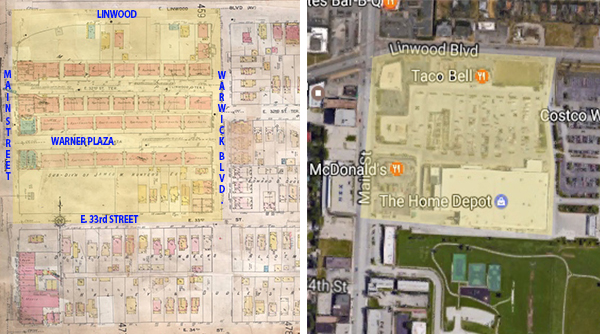
Former Home of Major William Warner
Major William Warner came to Kansas City to practice law in 1885 and was twice elected to Congress. He lived at 3255 Main Street, in a home once owned by Major B.F. Jones, a large frame house considered to be one of the most handsome lots in this part of the city. When Warner died in 1916, the Kansas City Star described his Main Street home:
could hold only a small portion of those who want to pay tribute to the man whose high character and rugged, kindly manhood reflected honor on the community. More than a thousand stood bareheaded underneath the shade trees outside. Hundreds more waited on the sidewalks and even across Main Street where scores who had dropped the duties of the day until those inside should have performed what could be performed for the man who was dead.
Hundreds of civil war veterans in blue mingled with gray uniformed men who had fought for the Confederacy. They talked softly, there under the trees, of Major Warner, who had fought with some of them, and against others, but who for half a century had been a friend to them all.
After Warner’s widow died, most of the estate went to their son John Warner.
“Most Beautiful Apartment Development Ever built”
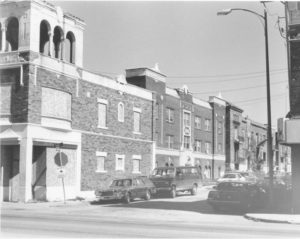
Warner Plaza in 1989, looking nw from Main Street.
By 1926, responding to a need for apartments in Kansas City, the McCandles Building Company announced plans to build an “apartment city” on the Warner site. With business frontage on Main and apartment frontage on a new street to be called Warner Plaza, the company began work on two seven-story buildings on Main and ten buildings with twelve apartments each along Warner Plaza.
The company’s newspaper ads promised “ the most beautiful apartment development ever built in Kansas City.” The builder extolled features including balcony porches, an aerial for radio built into the building, and both furnished and unfurnished kitchenette apartments. Among the buildings within Warner Plaza were El Capitan, a family hotel just north of 33rd Street, and the La Palma at 9 Warner Plaza.
By the end of the year, McCandles was selling off parts of his development.
There are scant records in old newspapers of life in Warner Plaza until the late 1980s when there was a push to renovate the apartments. In a 1991 editorial, the Star weighed in on Warner’s Plaza’s condition:
“The Warner Plaza area has vexed city officials, neighborhood groups and a succession of would-be developers for nearly a decade. A viable redevelopment is seen as a critical part of efforts to staunch neighborhood deterioration fed by prostitution, drug trade, and related crime.”
A year later, the Warner Plaza apartments were described as dilapidated and abandoned, looking out of place among newer businesses and buildings. It wasn’t until 2000 when the so-called Glover Plan helped replace the blighted tract with a new Home Depot and Costco. That plan, conceived by former Councilman Jim Glover, involved replacing the older housing units with new retail businesses and using sales tax revenues to improve nearby housing.
The photos below were taken during the period before the vacant Warner Plaza was razed.
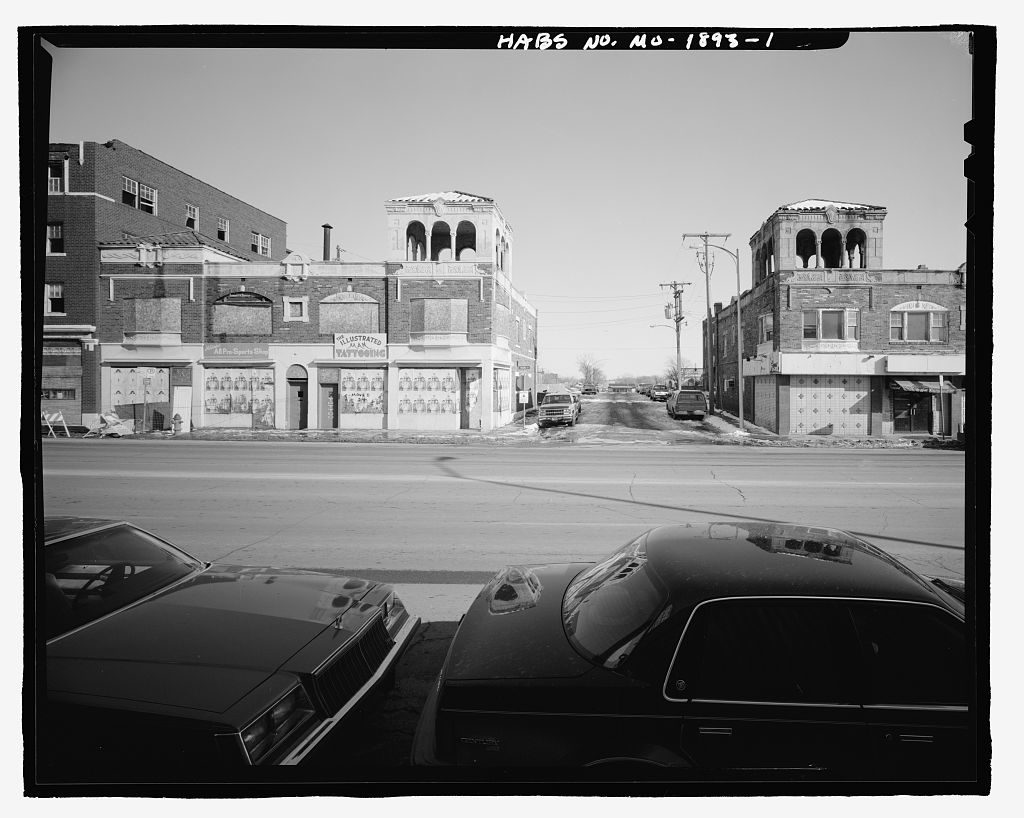
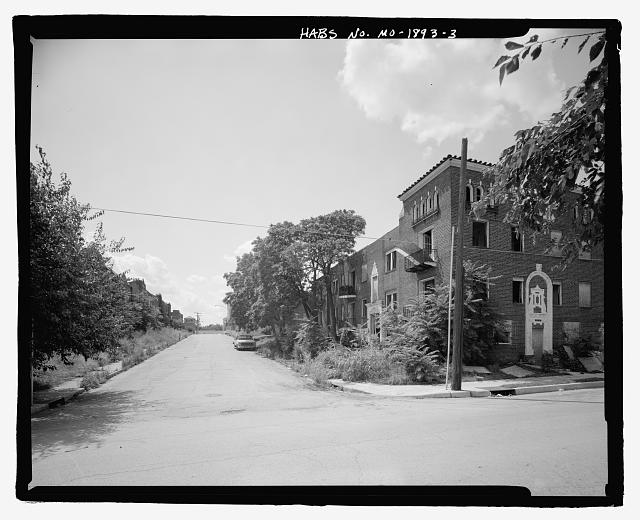
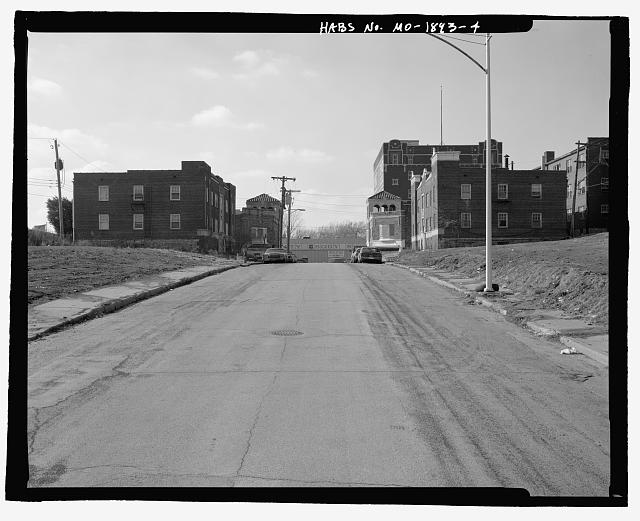
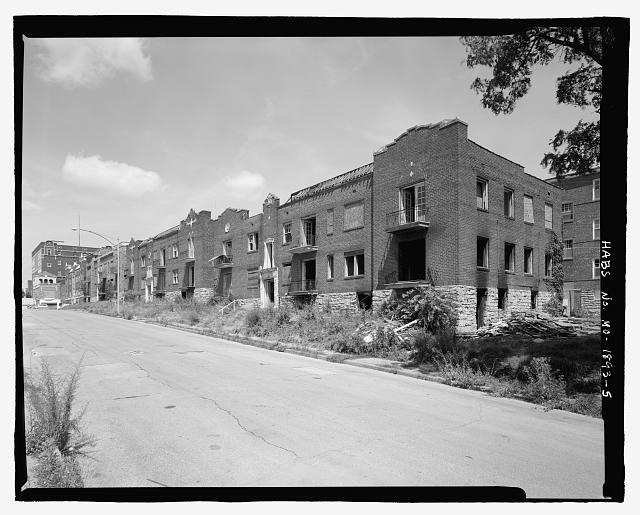
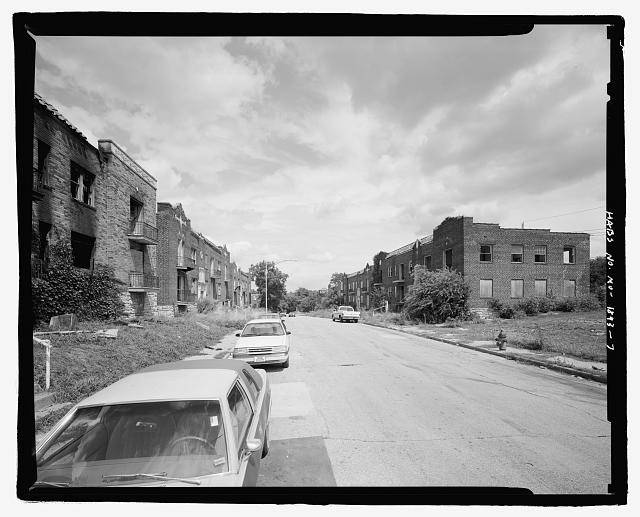
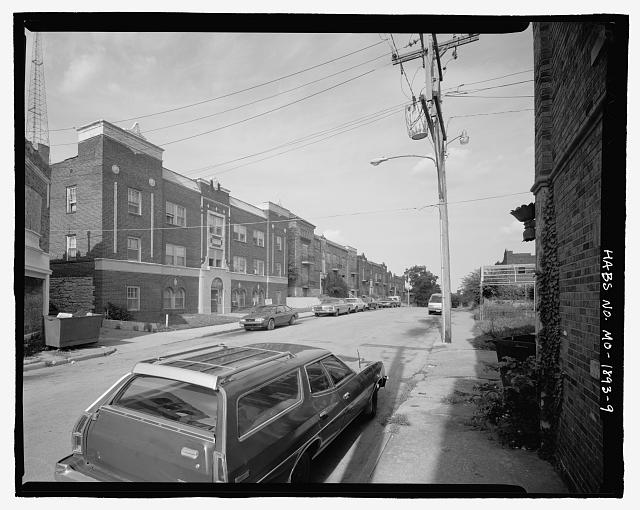
What is so sad, is even had they merely saved just a few of these buildings,(those two twin towered structured edifices and others that faced Main street right there), the Home Depot could have been built behind them and Warner Plaza street could have been used as the entrance to it. That would have given Main street the engaging type of architecture that is so greatly desired for light rail. These Warner plaza buildings could have been coffee shops or like businesses with apartments above… now we are suppose to shelve out another 100 million plus for another light rail stem to go along a corridor that has VERY FEW remaining structures conducive to a light rail experience. Almost all the buildings built along the Main corridor south of Union Station in the last 20 years have a suburban footprint with parking up front. The neighborhood associations have prostested against those newer types of structural footprints that undermind the pedestrian experience, and the designs of the newer buildings,such as the apartments currently being built next to Burger King near Armour, lack charm, and larger first floor windows to engage the pedestrians that will walk along this stretch. Unfortunately, I dont see this city ever learning from its continued mistakes.
By 2023, (which is the earliest we could possibly see a second light rail link up and running) it will probably be passe anyway; with the advent of generic self-driving cars, we can build however we like. Parking lots will be a relic of the past, we can build again in all the blown out blank spaces created between buildings. At that point, light rail will be a relic concept that no one will want to pay for or use any longer.
In the late 1970’s I lived in an apartment on Warner plaza. Miltons bar was still around the corner on Main, as was a tiki bar/restaurant , I believe it was called Kona Kai, but not 100 pct certain. Hookers and drug dealers sold their respective goods on the corner of Warner and main,beneath my second floor window, alongside and in front of Rays Playpen. The neighborhood was rough, seedy, and fairly dangerous after dark. Miltons bar was dark and seedy as well, one wall entirely covered in bounced checks dating back to the 1930’s. The entire area was a living breathing pulp detective novel. I loved living there, then again I was young and dumb back then.
Great memories….
I lived down the street that was between the two brick buildings in 1959, on E 32nd terr. The building on the left had Warner Plaza Drugs at street level the other corner had a little grocery store. I would love to have a picture of that street during that era. It was a really beautiful tree lined street with those old-fashioned kind of street lights that look like gas lights. All the apartment buildings were identical three-story brick buildings. I went to George B. Longan Elementary School. Thanks for the memories. 😊
I lived at 9 warner plaza when I was 4 or 5. My mom owned one of the small hotels. It was right behind what was the La Louisiane restaurant. Just down main was a gas station and the Kimo Theater. I remember going to the Kimo to see the movie Red Shoes. It was about a ballet dancer who when she put on the red ballet toe shoes couldn’t stop dancing. I was taking dancing at the conservatory of music which was in the Loose mansion near Armour and Main. That movie left an indelible mark on me, I took ballet until I was 14. Now, I am 75 and I still remember that movie! I am sad to see that the Home Depot is there! I also lived on Central and Armour just across from what was then the Westport Arms apt. That place I lived there from 7 or 8 till I was in college. That got torn down for the parking lot of a big office building where the Colonnade apt were. Guess I can’t win!
I love this post. We lived there in the late 70’s, I can remember the steps that were on the side of 7 Eleven leading to Linwood. Going to Lamar’s was a treat too. Great memories!
I have so many memories there. We lived there 2x, When I was around 2 or 3, We lived at a corner apt above the Ray’s haha and across from Brown’s chicken. Then the 2nd time we lived there I believe it was 32nd ter. I remember walking all around there and playing outside with other kids. I went to George B Logan elementary school. The KFC and Church’s were right across the street from each other. Linwood superfoods was a great place to get ice cream. Lamar’s gave us kids free donuts after school on Wed or Thur, can’t remember. Then the steps on the side of 7 eleven that took you down from warner plaza to the Linwood side. between taco bell. Great memories!
Great post! Thanks for sharing!
What year was the dreadful deadly fire that led to the final demise of Warner Plaza apts.??
What year was the dreadful deadly fire that led to the final demise of Warner Plaza apts.?? Around 1990ish ??
The fire displaced many & took the lives of those who couldn’t get out. It made front page of the Kansas City (Star/Times).